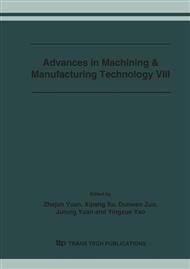p.651
p.656
p.661
p.666
p.671
p.676
p.681
p.686
p.691
A New Magnetic Polishing Liquid (MPL) for Precision Surface Finishing
Abstract:
This paper presents a new magnetic polishing liquid (MPL) produced by mixing sub-micron or micron order abrasive particles into a magnetic compound fluid (MCF) and its fundamental performance in surface finishing. MCF is an intelligent fluid, which is developed by mixing a magnetic fluid (MF) and a Magneto-rheological fluid (MRF) into a solvent, and hence reacting upon magnetic fields. In the present work, seven kinds of kerosene-based MPLs were prepared. The hydrodynamic characteristics of MPLs such as the viscosities under different magnetic fields were investigated. The obtained result indicated that the viscosity increases with the growing of the magnetic field and that the type of MPL affects greatly the viscosity. This phenomenon was discussed by observing the magnetic clusters formed in MPL. It was observed that the magnetic clusters are distributed along the magnetic fluxes. An experimental result indicated that the surface roughness varies with polishing time and gets smallest at a certain value of magnetic field strength.
Info:
Periodical:
Pages:
671-675
Citation:
Online since:
July 2006
Authors:
Price:
Сopyright:
© 2006 Trans Tech Publications Ltd. All Rights Reserved
Share:
Citation:


